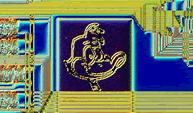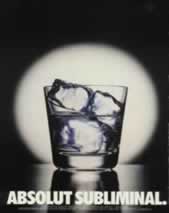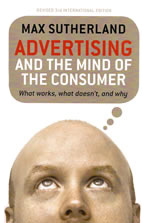![]() Receive new posting via RSS feed. >Click the icon on the left to subscribe.
Receive new posting via RSS feed. >Click the icon on the left to subscribe.
(Or right click the icon to copy and paste the link into your rss reader)
Subliminal Advertising, Like Energizer Bunny, Just Keeps Going… and Going.
By Max Sutherland
Do subliminal ads really work? Like the Energizer bunny, the brouhaha surrounding subliminal advertising just keeps going… and going. In the last few years, heavyweights such as McDonalds and KFC have been accused of using ‘subliminal advertising’. As has George W. Bush. Why? What's behind all this?
 On cable TV during an episode of Iron Chef America on the Food Network, a frame of the McDonalds golden arches was discovered in the program. You can view it here.
On cable TV during an episode of Iron Chef America on the Food Network, a frame of the McDonalds golden arches was discovered in the program. You can view it here.
The network later explained …"It was a technical error on our part and not a subliminal message as suggested by a website running the slow-motion playback," (Food Network spokesman Mark O'Connor.)
 And when George W. Bush was running for President against Al Gore, the Republicans were also under fire, accused of using subliminals in their ads. If you look really closely you might just be able to see the word RATS flashed on the screen in the last 20% of this Republican TV ad.
And when George W. Bush was running for President against Al Gore, the Republicans were also under fire, accused of using subliminals in their ads. If you look really closely you might just be able to see the word RATS flashed on the screen in the last 20% of this Republican TV ad.
As with the McDonalds commercial, no-one ever really provided a satisfactory explanation as to how this got in there. It makes people think “hmm…. why is it there? Maybe I really should be afraid.”
KFC jolted people upright by telling USA consumers last year that there was a hidden password in one of their USA TV ads. Discover the password and get a free sandwich, they offered. People could use their DVD recorders to watch in slo-mo and get the password. It created a lot of buzz and prompted viewing of the ad … intently. It also triggered people to wonder, yet again about ‘subliminal’ ads and what effect they really have.
Hoax
The truth is that subliminal advertising is a hoax initiated by a marketing consultant, James Vicary, in the 1950’s. The effect that he reported, of flashing “Drink Coca-Cola” and “Eat popcorn” in a movie theater, struck fear into the public’s mind. Two decades later (in the 1970’s) Vicary admitted that he fabricated his movie theater experiment as a means of promoting his marketing consultancy.
The whole idea was a hoax all along but the public still believes that it works. The fear of subliminal advertising didn’t go away. By the time, Vicary’s admission became public, Wilson Bryan Key #1 had also helped fan the flames of controversy with all his stuff on embeds (e.g. the word sex hidden in the ice cubes of the Gilbeys Gin ad).
Myth will outlast fact and as recently as last year (April 2006), the respected magazine New Scientist re-entered the fray with an article entitled “Subliminal Advertising May Work After All”. Based almost entirely on a study called: “Beyond Vicary’s fantasies: The impact of subliminal priming and brand choice”#2 , it showed that the words ‘Lipton Ice Tea’, screened subliminally, seemed to influence a later choice of beverage (Lipton Ice Tea vs. Spa Rood mineral water). Leaving aside the methodological limitations (like confounding brand name and product type), the audience had to be in a high need state (i.e. already very thirsty) for the effect to occur.
Effect
Subliminally flashed images can influence mood and influence a feeling of familiarity with a product but the evidence of its impact on actual choice is very spotty. Pratkanis and Aronson #3 exhaustively researched the literature in 1991 and noted that more than 200 scientific studies had failed to replicate the original study. For every research study that comes along that shows any effect on choice, there are other studies that fail to find such an effect (see for example this one #4 that uses hidden words in music to try to influence choice).
 The spotty evidence is just one reason that the fears don’t go away. The other reason is that from time to time, an embed is still discovered in an ad, a movie, a TV program or whatever…and people wonder why the heck it would be there if this stuff really doesn’t work. For example, when Lion King, the movie was released, Disney found itself under huge attack from accusers who said the word S-E-X could be discerned in the dust as the lions were playing.
The spotty evidence is just one reason that the fears don’t go away. The other reason is that from time to time, an embed is still discovered in an ad, a movie, a TV program or whatever…and people wonder why the heck it would be there if this stuff really doesn’t work. For example, when Lion King, the movie was released, Disney found itself under huge attack from accusers who said the word S-E-X could be discerned in the dust as the lions were playing.
Practical Joke
In my book, Advertising and the Mind of the Consumer I pointed out that these things are motivated often by boredom or a need for self-expression and a practical joke. It is very easy for someone to put something in an ad, a movie or wherever – and it usually goes undetected. (I know one case personally.)
Some years ago, in the London Daily Mirror, owned then by the infamous Robert Maxwell, one of his staff inserted a cartoon with the words, ‘F**k Maxwell’ hidden in tiny letters among the squiggles.#5 Ask yourself, was he practicing some sort of mind manipulation or was this cartoonist just finding an expressive outlet for his angst?
 Most of this stuff is visual graffiti and it can be discovered sometimes in the strangest places - even on computer chips (see Daffy Duck image on a microchip, detectable only when put under a microscope.) Usually only the perpetrators ever know these things are there.
Most of this stuff is visual graffiti and it can be discovered sometimes in the strangest places - even on computer chips (see Daffy Duck image on a microchip, detectable only when put under a microscope.) Usually only the perpetrators ever know these things are there.
I’m not saying that all instances of subliminal advertising that are discovered, originate from practical jokes but that’s what most of them are. When these are discovered, they nevertheless feed the public’s fear that subliminal advertising works, that it is widespread and that it is covertly seducing us all.
Mystique
For those people who get off on mystique and want to believe in anything from conspiracies to alien abductions, this fits right in. In the entertainment industry, mystique programs like the X Files and Heroes, rate well and this myth of subliminal advertising fits right into the genre. If you have time, check out this video where entertainer, Derren Brown turns the tables on advertising copywriters and uses subliminal influence to affect the copy that they create. If you believe that, and you truly want a credibility stretch, check out this other one where he uses ‘subliminals’ to influence people’s choice of birthday gift. Showmanship rules!
Send-Up
 KFC using a hidden password in their TV ad were hardly the first advertiser to use a tongue in cheek, approach to subliminal advertising. Absolut vodka for example ran one some years back with the headline "Absolut Subliminal". More recently, KFC announced a $10 gift certificate to the first 1000 kids who correctly guessed where a ‘mosquito ringtone’ (a high-pitched sound kids ears only are supposed to hear) was placed in a KFC TV commercial. (Watch the ad here and see if you can hear the sound...I could.).
KFC using a hidden password in their TV ad were hardly the first advertiser to use a tongue in cheek, approach to subliminal advertising. Absolut vodka for example ran one some years back with the headline "Absolut Subliminal". More recently, KFC announced a $10 gift certificate to the first 1000 kids who correctly guessed where a ‘mosquito ringtone’ (a high-pitched sound kids ears only are supposed to hear) was placed in a KFC TV commercial. (Watch the ad here and see if you can hear the sound...I could.).
All this is good fun but it does cause a lot of head scratching, each time, about subliminal advertising and why it is there and whether it works.
Conclusion
It is true that there are situations where it can be advantageous for advertisers to communicate outside the full glare of attention. It helps obviate the triggering of conscious defences and counter-arguing. There is also no doubt that subliminal images can influence mood and can create a feeling of familiarity with a product that has not been seen before.#6 But there are already successful and accepted ways to do all that. Product placement is one way. Messages in masquerade are another. Fears of subliminal effects have been grossly overblown while subtle effects that are not so ‘hidden’ from consciousness have much more impact. Advertisers have little need to bury obscure images in ice cubes or rely on things flashed rapidly at sub-threshold speeds, all for uncertain effect.
It is still widely believed that subliminal advertising was made illegal in the USA. In fact, no such legislation was passed (although it was in a number of other countries including the UK and Australia).
You can bet however, that all the fuss over subliminal advertising will keep on going...and going... because you don’t have to be a bunny to be goaded into thinking that this must be real, and widely practised. As Mark Twain once observed: “A good lie will have traveled half way around the world while the truth is putting on her boots.”
Notes1. Wilson Bryan Key, Subliminal Seduction, Signet, N.Y., 1972
2. Karremans, J. C., W. Stroebe, et al. (2006). "Beyond Vicary’s fantasies: The impact of subliminal priming and brand choice." Journal of Experimental Social Psychology.
3. A. Pratkanis & E. Aronson, Age of Propaganda, W.H. Freeman, N.Y, 1991, p. 201
4. Egermann, H., R. Kopiez, et al. (2006). "Is there an effect of subliminal messages in music on choice behavior?" Journal of Articles in Support of the Null Hypothesis 4(2).
5. Roy Greenslade, Maxwell's Fall, Simon & Schuster, London, 1992, P. 99
6. Johar, G. V., D. Maheswaran, et al. (2006). "MAPping the Frontiers: Theoretical Advances in Consumer Research on Memory, Affect, and Persuasion." Journal of Consumer Research 33: 139-149.


